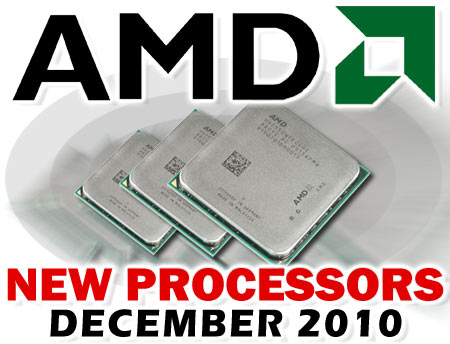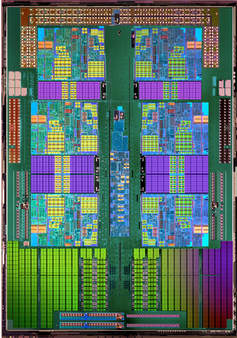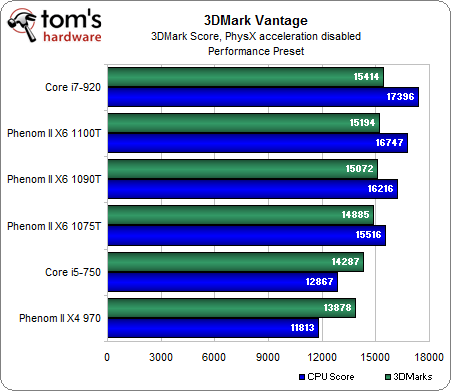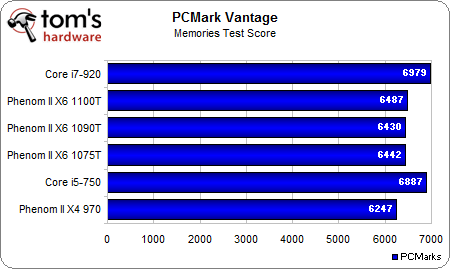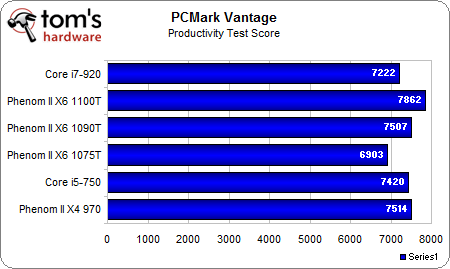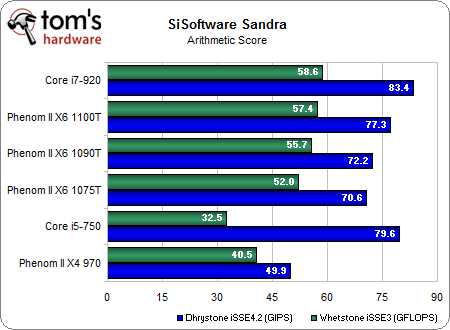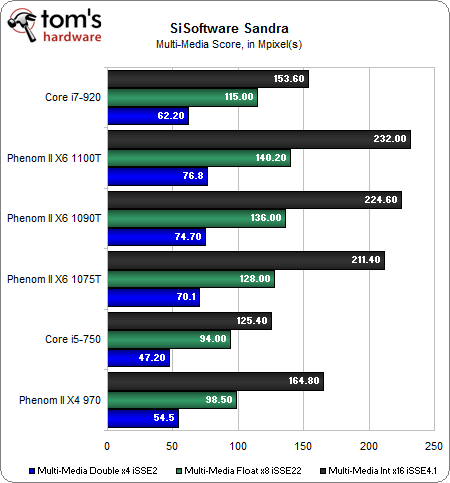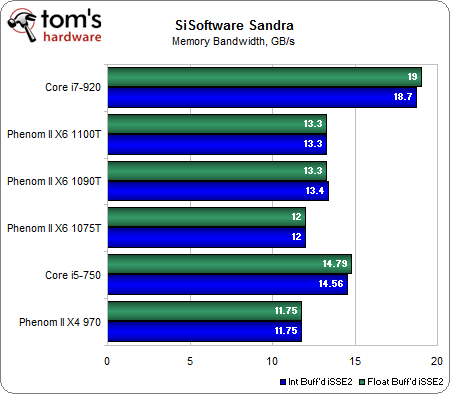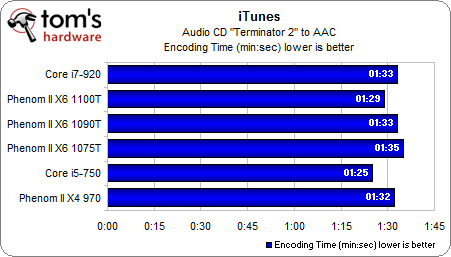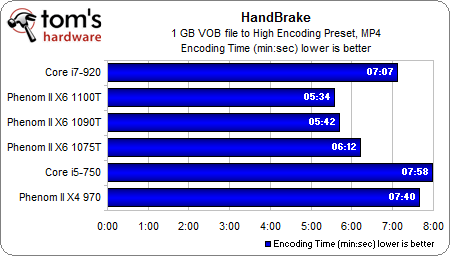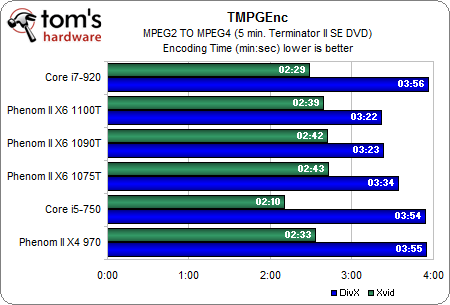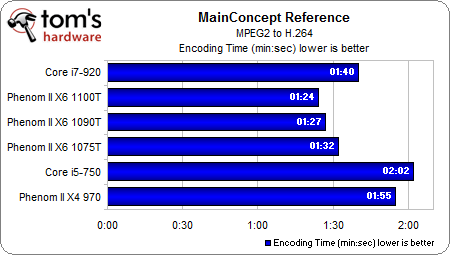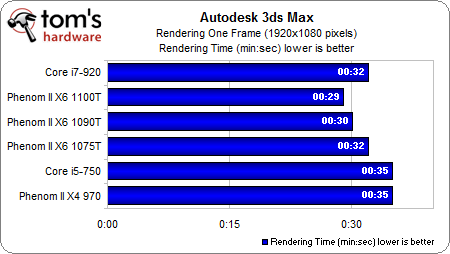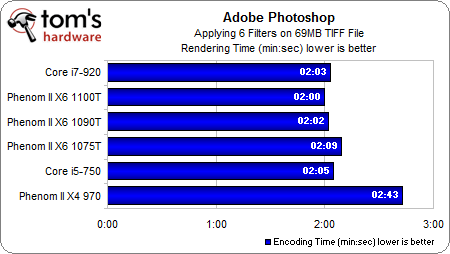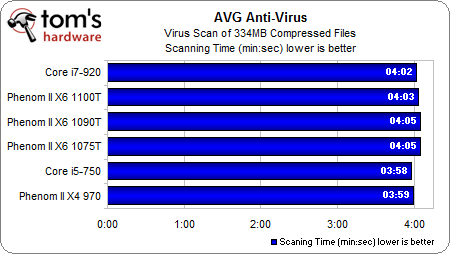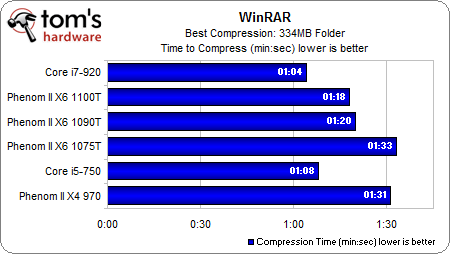|
TopNax |

AMD Phenom II X6 1100T Review: The New Six-Core Flagship
|
|
AMD knows that we're impatiently waiting for some traction on Fusion. And while we expect to see its first notebook-oriented Fusion-based processors featured in actual products at CES, we're still a ways away from seeing the technology in action on the desktop. In the meantime, AMD is trying to tide us over with a steady stream of frequency bumps. It seems like that has been the case for a while now, but as the company improves its 45 nm manufacturing process, it's able to reliably get incrementally more headroom to boost performance--even if it's only bit by bit. This strategy isnít viable long term, of course, especially in the face of Sandy Bridge launching in January at CES, aiming for the same mainstream market. It tided the company over in 2010, though, allowing it to offer excellent prices on processors that performed very well, despite Intel's lock on the high-end segment.
Perhaps the best part of this approach is that, every time AMD introduced a new model over the last year, the faster processors have adopted the MSRP of the models they replace. This time is no different, and the result is a wave of price drops dribbling down the Athlon II and Phenom II product lines. Once Sandy Bridge hits, AMD is going to have a hard time leaning on its current approach. We're simply expecting too much pressure on its higher-end models from Intel's LGA 1155 lineup. For now, the Athlon II and Phenom II processors remain viable options for enthusiasts looking for plenty of performance without dropping a lot of cash. Remember, we still don't have official pricing on the Sandy Bridge parts, so it could turn out that AMD retains its value proposition moving into 2011. This time around, AMD is refreshing the Athlon II X3, Phenom II X2, and Phenom II X6 families. Even the Thuban-based six-core X6 can overclock up to 4 GHz relatively easily. So, it's not a stretch to expect another speed bump or two from some of AMD's lower-clocked parts as we traverse through the next year, even once Bulldozer-based parts start shipping. Knowing that day is coming, is it worth sinking money into a new Socket AM3 platform now? Both Intel and AMD are gearing up for a next-generation battle, after all. Let's take a closer look.
Guess how much faster the new Athlon II X3 455 is compared to the older 450 model? If you guessed 100 MHz, give yourself a cookie. While the speed bump is hard to get excited about, an $87 triple-core CPU at 3.3 GHz is far from a boring proposition. Once again, AMD has cemented its lock on the sub-$100 processor market. ††††† Phenom II X6 1100T Black Edition
The Phenom II X6 1100T is AMDís new flagship model, displacing the Phenom II X6 1090Tís top spot. With a base 3.3 GHz clock and a maximum Turbo CORE speed of 3.7 GHz, this new CPU basically increments the X6 lineup by 100 MHz compared to its predecessor. The real news here is that the Phenom II X6 1100T is priced at $265, $30 cheaper than the 1090T's launch MSRP.† Even more impressive is that the Phenom II X6 1090T Black Edition can be had for $230 on Newegg right now, and the Phenom II X6 1075T is available for a flat $200. This aggressive pricing drives the cost of six-core computing down quickly, and folks looking for a new workstation PC should be giving the Phenom II X6 line some serious consideration if you're comfortable with desktop-class components.
|
|
Page1 |
|
Home†††††† Previous††††††† AMD page†††††††† Intel page†††††††† Next |
|
Benchmark Results: Synthetics
The blue bars represent CPU performance and the green bars represent the aggregate 3DMark score. Note that the blue CPU results continue to rise with the more capable processors, while the 3DMark score tapers off when the graphics card caps out. This gaming benchmark appears to favor Intel architecture. Nevertheless, the new Phenom II X6 1100T performs similarly as the Core i7-920.
The PCMark system and memories benchmarks also favor Intel CPUs, but the productivity benchmark takes good advantage of the Phenom II X6 1100T's extra execution cores and high clock speed.
While the Sandra CPU arithmetic benchmark favors Intel processors, the Whetstone iSSE3 tests perform better on similarly-priced AMD products. Once again the new Phenom II X6 1100T performs close to the Core i7-920. The Sandra CPU multimedia results are notably higher on the AMD processors. Intelís offerings demonstrate superior memory bandwidth in the Sandra memory benchmark, especially in the case of the Core i7-920óthe only product in our review that boasts a triple-channel memory interface.
Benchmark Results: Applications
iTunes shows less than a ten second delta between processors. The Core i5-750 scores a win here, but the new Phenom II X6 1100T is only a few seconds behind.
HandBrake and its MP4 encoder makes great use of multiple processing threads. As a result, the hexa-core AMD products score a huge win in this benchmark.
The DivX and MainConcept encoding routines show a massive performance advantage with the Phenom II X6ís extra processing cores, but the Xvid encoder favors Intel architecture and higher clock speeds.
The Autodesk 3ds Max benchmark results in a close playing field with a slight advantage for the Phenom II X6 and Core i7-920, but with slightly lower results for the quad-core i5-750 and Phenom II X4. Photoshop performance ends in a virtual tie with the exception of the Phenom II X4 970, a CPU that struggles in this benchmark.
The AVG results show a curious tie between these quad- to six-core processors.
WinRAR shows an indisputable preference for Intel architecture, but 7-Zip makes good use of threading, and the Phenom II X6 processors gain an advantage here.
|
|
††††††††††††††††††††††††††††††††††††††††††††††††††††††††††††††††††††††††††††††††††††††††††††††††††††††††††††††††††††††††††††††††††††††† Athlon II X3 455
Guess how much faster the new Athlon II X3 455 is compared to the older 450 model? If you guessed 100 MHz, give yourself a cookie. While the speed bump is hard to get excited about, an $87 triple-core CPU at 3.3 GHz is far from a boring proposition. Once again, AMD has cemented its lock on the sub-$100 processor market. |
|
Test Systems And Benchmarks Weíre concentrating on the new Phenom II X6 1100T flagship in our benchmarks. While the Athlon II X3 455 and Phenom II X2 565 are interesting processors, the 100 MHz speed bump probably wonít show much of an improvement over previous tests that weíve performed. We are interested in seeing if the new top-of-the-line model can be overclocked higher than the 1090T, though. To this end, we've equipped our test bed with a Cooler Master Hyper 212 Plus CPU cooler. Weíre including the Phenom II X6 1090T and 1075T for comparison purposes. The Phenom II X4 970 and Core i5-750 are also present to represent similarly-priced quad-core performance. Finally, the Core i7-920 shows what the starting point of Intelís more expensive high-end offerings can accomplish. Take note that the Core i7-920 sample we have on hand is an engineering sample with a lower memory multiplier than the retail version. This will hurt the Core i7-920 in some memory-dependent tests, but for the most part performance should remain comparable to the commercially-available processor.
|
|
††††††††† Phenom II X2 565 Black Edition
As with the Phenom II X6 1100T, AMD's Phenom II X2 565 gets a 100 MHz speed boost, up to 3.4 GHz. The $115 MSRP buys 6 MB of L3 cache and the Black Editionís unlocked multiplier for simpler overclocking endeavors. As with all of the Phenom II X2 line there's a chance (not a guarantee) that some dormant CPU cores can be enabled, morphing this budget CPU into a triple-core Phenom II X3 or quad-core Phenom II X4. |
|
† Home†††††† Previous††††††† AMD page†††††††† Intel page†††††††† Next |
|
|
Phenom II X6 1100T BE |
Phenom II X6 1090T BE |
Phenom II X6 1075T |
|
Codename: |
Thuban |
Thuban |
Thuban |
|
Process: |
45 nm |
45 nm |
45 nm |
|
CPU Cores: |
6 |
6 |
6 |
|
Clock Speed (Max Turbo): |
3.3 GHz (3.7 GHz) |
3.2 GHz (3.6 GHz) |
3.0 GHz (3.5 GHz) |
|
Socket: |
AM2+/AM3 |
AM2+/AM3 |
AM2+/AM3 |
|
L1 Cache: |
6 x 128 KB |
6 x 128 KB |
6 x 128 KB |
|
L2 Cache: |
6 x 512 KB |
6 x 512 KB |
6 x 512 KB |
|
L3 Cache: |
6 MB |
6 MB |
6 MB |
|
HyperTransport: |
4000 MT/s |
4000 MT/s |
4000 MT/s |
|
Thermal Envelope: |
125 W |
125 W |
125 W |
|
|
Athlon II X3 455 |
Athlon II X3 450 |
Athlon II X3 445 |
|
Codename: |
Rana |
Rana |
Rana |
|
Process: |
45 nm |
45 nm |
45 nm |
|
CPU Cores: |
3 |
3 |
3 |
|
Clock Speed: |
3.3 GHz |
3.2 GHz |
3.1 GHz |
|
Socket: |
AM2+/AM3 |
AM2+/AM3 |
AM2+/AM3 |
|
L1 Cache: |
3 x 128 KB |
3 x 128 KB |
3 x 128 KB |
|
L2 Cache: |
3 x 512 KB |
3 x 512 KB |
3 x 512 KB |
|
HyperTransport: |
4000 MT/s |
4000 MT/s |
4000 MT/s |
|
Thermal Envelope: |
95 W |
95 W |
95 W |
|
Test Systems |
|
|||
|
|
AMD System A |
AMD System B |
Intel LGA 1156 System |
Intel LGA 1366 System |
|
Motherboard |
Gigabyte MA790XT-UD4P |
Asus M4A785TD-V EVO |
Asus P7P55D-E LX |
Gigabyte X58A-UD3R |
|
Processor |
Phenom II X6 1100T |
Phenom II X6 1075T |
Intel Core i5-750 |
Intel Core i7-920 |
|
CPU Cooler |
Cooler Master Hyper 212 Plus |
†††††††††††††††††† Cooler Master Hyper TX3 |
ZEROtherm Nirvana NV120 |
|
|
Memory |
†††††††††††††††††††††††††††††††††††††††††††††††††††††††††† Crucial DDR3-1333 |
Mushkin PC3-10700H |
||
|
Graphics |
†† MSI GeForce GTX 470 |
|||
|
Hard Drive |
Western Digital Caviar Black 640 GB |
|||
|
Benchmark Configuration |
|
|
3D Games |
|
|
Crysis |
Patch 1.2.1, DirectX 10, 64-bit executable, benchmark tool |
|
DiRT 2 |
In-game benchmark |
|
StarCraft 2 |
Custom Tom's Hardware Benchmark |
|
Audio/Video Encoding |
|
|
iTunes |
Version: 9.0.2.25 x64 |
|
HandBrake 0.9.4 |
Version 0.9.4, convert first .vob file |
|
TMPGEnc 4.0 Express |
Version: 4.7.3.292 |
|
DivX 6.9.1 |
Encoding mode: Insane Quality |
|
XviD 1.2.2 |
Display encoding status = off |
|
MainConcept Reference 1.6.1 |
MPEG2 to MPEG2 (H.264), MainConcept H.264/AVC Codec |
|
Productivity |
|
|
Adobe Photoshop CS4 (64-bit) |
Version: 11.0 x64, Filter 15.7 MB TIF Image |
|
Autodesk 3ds Max 2010 |
Version: 11.0 x64, Rendering Dragon Image at 1920x1080 (HDTV) |
|
Grisoft AVG Anti-Virus 9.0 |
Version: 9.0.663, Virus base: 270.14.1/2407 |
|
WinRAR 3.90 |
Version x64 3.90, Dictionary = 4096 KB, Benchmark: THG-Workload (334 MB) |
|
7-Zip |
Version 4.65: Format=Zip, Compression=Ultra, |
|
Synthetic Benchmarks |
|
|
3DMark Vantage |
Version: 1.01, GPU and CPU scores |
|
PCMark Vantage |
Version: 1.0.1.0 x64, System, Memories, Productivity, Hard Disk Drive benchmarks |
|
SiSoftware Sandra 2010 |
Version 2010.1.16.11, CPU Test = CPU Arithmetic / MultiMedia, Memory Test = Bandwidth Benchmark |
|
|
Phenom II X2 565 |
Phenom II X2 560 |
Phenom II X2 555 |
|
Codename: |
Callisto |
Callisto |
Callisto |
|
Process: |
45 nm |
45 nm |
45 nm |
|
CPU Cores: |
2 |
2 |
2 |
|
Clock Speed: |
3.4 GHz |
3.3 GHz |
3.2 GHz |
|
Socket: |
AM2+/AM3 |
AM2+/AM3 |
AM2+/AM3 |
|
L1 Cache: |
2 x 128 KB |
2 x 128 KB |
2 x 128 KB |
|
L2 Cache: |
2 x 512 KB |
2 x 512 KB |
2 x 512 KB |
|
L3 Cache: |
6 MB |
6 MB |
6 MB |
|
HyperTransport: |
4000 MT/s |
4000 MT/s |
4000 MT/s |
|
Thermal Envelope: |
80 W |
80 W |
80 W |
